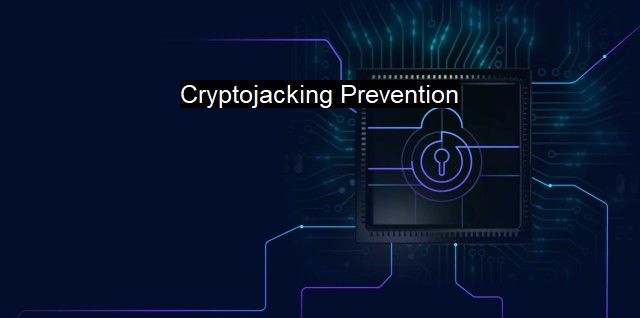What is Cryptojacking Prevention?
Safeguarding Digital Wealth: A Guide to Cryptojacking Prevention and Protection Against Cryptocurrency Mining Malware
Cryptojacking prevention refers to a set of specific measures designed to protect computer systems from a type of cyber-attack known as cryptojacking. This term is becoming increasingly prevalent in discussions revolving around cybersecurity and antivirus protection, largely due to the exceptional rise in the value of digital currencies.Cryptojacking itself involves unauthorized use of a computer system's resources to mine cryptocurrencies. Cybercriminals instigate it through malware or malicious scripts that initiate cryptomining processes in the compromised system's background. Cryptojacking is not always immediately apparent, as its effects often masquerade as minor annoyances like slower performance or increased energy usage. prolonged exploitation can lead to significant system damage and theft of personal sensitive data.
Cryptojacking prevention has become a central defense line in cybersecurity strategies as incidences of cryptojacking attacks are surging. Strategizing cryptojacking prevention starts with understanding how these attacks work. Typically, cryptojackers access a computing system in one of two ways. They might infect a website with malicious code, so any visitor's computer starts mining cryptocurrency, or they can infiltrate a system directly via an email pose enabling them to install cryptomining scripts or processes.
The later advancements in browser-based mining techniques don't necessarily require a user to click links or download files, merely visiting a compromised website can start the cryptomining process in the background of a user’s device without their knowledge or consent. All these incidences increase the significance of robust cryptojacking prevention practices not only as part of cybersecurity but on the internet hygiene forefront as well.
There are several steps you can take to prevent cryptojacking. Firstly, it is imperative that all software, operating systems, and applications continually update. Cybercriminals often exploit known security vulnerabilities in older versions of software. Regular patching provides necessary security fixes, helping keep cryptojackers at bay. VPN use can also add a layer of protection from cryptojacking. While VPNs are commonly used to secure internet connections and protect privacy, they can also block malicious sites and hidden mining scripts.
Similarly, installing a credible antivirus or anti-malware software that offers comprehensive protection against malware, including cryptojacking scripts, is indisputably vital. Reputable cybersecurity software recognizes and blocks malicious cryptomining codes, thus providing an essential tool in cryptojacking prevention.
It is essential to use ad-blockers or browser extensions that prevent cryptojacking scripts from loading in the browser. As most cryptojacking cases start through malicious browser scripts, blocking these scripts beforehand considerably reduces cryptojacking-related security risks.
Users should recognize and avoid phishing emails that may contain cryptojacking scripts and be cautious of engaging unsolicited downloads or clicking on unfamiliar links. Some organizations have even enacted cryptojacking-specific policies to educate employees about cryptojacking and delineate best practices to deflect potential attack attempts.
It is vital to acknowledge that despite using a powerful set of preventative tools and tactics, there might still be cryptojacking risks. This is because cryptojackers continue to evolve their methods. For instance, the emergence of fileless cryptojacking, where malicious code resides in the system's memory rather than hard drive, poses a significant challenge to antivirus software.
With the invasive and sinister nature of cryptojacking, hackers also seek weaknesses in internet-connected devices, like smartphones and smart TVs, to expand their illicit cryptomining operations. Therefore, cryptojacking prevention should not only exist on traditional computing devices but extend to protecting all IoT devices.
Cryptojacking prevention lives at the intersection of an array of proactive security measures, regular system checks, and continually staying informed of evolving threat landscapes. When combined efficiently, these elements provide the best way to prevent unauthorized parties from hi-jacking computer resources for their gain. It's an ongoing, shared duty making sure that steps are taken to prevent hostile takeover of devices. It's clear cryptojacking prevention must be a priority.

Cryptojacking Prevention FAQs
What is cryptojacking?
Cryptojacking is a type of cyberattack where malicious actors hijack a victim's computer or other devices to mine cryptocurrencies without their knowledge or consent. This hijacking can slow down the victim's device and potentially cause damage if left unchecked.How do I know if my device has been cryptojacked?
Some common signs of cryptojacking include slow device performance, increased CPU usage, and higher electricity bills. You may also notice strange pop-up ads or notice that your device is overheating. It's important to regularly monitor your device's performance and investigate any unusual activity.How can I prevent cryptojacking?
To prevent cryptojacking, you should install a strong antivirus program and keep it updated regularly. In addition, you should avoid clicking on suspicious links or downloading unverified applications. Another effective prevention method is to use ad-blockers and anti-cryptomining extensions for your browser. These measures can help reduce the risk of a successful cryptojacking attack.What should I do if I suspect my device has been cryptojacked?
If you suspect your device has been cryptojacked, you should immediately disconnect your device from the internet and run a full scan with your antivirus program. It's also a good idea to change your passwords and monitor your financial accounts for any unusual activity. If you are unable to remove the cryptojacking software yourself, it's recommended that you seek the help of a cybersecurity professional.| | A | | | B | | | C | | | D | | | E | | | F | | | G | | | H | | | I | | | J | | | K | | | L | | | M | |
| | N | | | O | | | P | | | Q | | | R | | | S | | | T | | | U | | | V | | | W | | | X | | | Y | | | Z | |
| | 1 | | | 2 | | | 3 | | | 4 | | | 7 | | | 8 | | |||||||